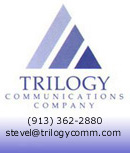
Presentation Skills and Strategy
Seminar
Content
|
|
|
|
|
|
Organizing
winning presentations
You'll learn an organizational technique so simple that it can be used
on the back of a napkin.
Plus, you'll discover practical, easy ways to assess your audience and
develop presentations with solutions to strategically match your audiences'
needs.
Improving
your personal presentation
performance
The Trilogy method doesn't waste time trying to change your own personal
presentation style – instead, the seminar builds on your strengths
and identifies weaknesses you can avoid. You'll learn how to control nervousness,
confidently deal with props and audio/visual materials and how to handle
mistakes with ease.
Involving
the audience and getting the decision
you want
You'll discover powerful ways to involve and surprise your audience while
reducing the risk of losing control. In addition, you'll learn proven
communications techniques to help you get more business and truly create
a win-win solution for you and your audience.
Preparation
Prior
to the session, each attendee will be asked to complete a pre-seminar
form. This simple form summarizes any previous presentation experience,
provides a self-evaluation of presentation skill strengths and weaknesses
and asks for a review of those items that make the attendee most nervous
when making a presentation. This self-evaluation allows the instructor
to tailor elements of the seminar to meet the individual needs of each
participant.
In addition, each sponsoring company is asked to provide information about the desired corporate objectives. This seminar is an investment of both corporate time and money and it's important that goals and objectives are defined to get the best return on your corporate investments.
Participants are asked to develop a short (3-minute) presentation on any non-business subject of their choice prior to the first day's class. In addition, the development of a short business presentation is required for the second day of the seminar.
DAY ONE
Presentation practice: each participant presents for three minutes on any non-business topic of their choice
These sessions are videotaped (the video tape stays with the participant throughout the seminar so he or she can view personal progress throughout the sessions). The instructor provides a short private critique and personal coaching session immediately after each presentation.
Defining
a presentation:
- the key element required for any successful presentation
Audience/strategy:
- a proprietary audience profiling system you can use immediately
- determining the
UDM (Ultimate Decision Maker)
- never-fail questions
to ascertain your prospect's "real" needs
- organizing the
presentation for your audience and developing a
- winning strategy
- dealing with multiple
decision makers
- profiling actual current audiences
- revising the previous presentation vis-a-vis the audience
Content/strategy:
- "the power of three" — a proven, simple, organizational tool to
- help you develop powerful, persuasive presentations
- strategically targeted to the decision
you desire
- "getting to yes"
— trial closes to get the decision you want
- simple presentation
content format
- complex presentation
content format
- involving your
audience
- surprising your
audience
Exercises
include:
- reorganizing the 3-minute presentation using the "power
- of three"
Control:
- conquering the
fear of losing control of - and handling
- disruptions in - a meeting or presentation
through the effective
- use of:
—————————
agenda
—————————
presence
—————————
physical action
Presentation
practice: re-presenting
the 3-minute presentation on video employing the learning gained throughout
the day.
The instructor provides a short personal coaching and critiquing session immediately after each presentation.
DAY TWO
Presentation practice: each participant presents for five minutes on a business topic of their choice.
These sessions are also video taped. The instructor provides a short critique and personal coaching session immediately after each presentation.
Presence:
- carriage and dress
- the hidden power
of superstitions
- voice power with
scripting tips
- eye contact
- cadence with scripting
tips
- handling nervousness
- movement and gestures
- formality/informality
Exercises
include:
- discovering/increasing vocal range
- increasing eye
contact comfort zone
- discovering and
overcoming personal nervousness issues
Using
props:
- the three cardinal rules of using props
- using Powerpoint™/slides
effectively
- using physical
props and understanding the power –
and
- potential liability of – the "Christmas
syndrome"
- using the right
chart for your audience
Using
props:
- using flip charts with ease
- using overhead
projectors
- using video
- using reveals
Exercises
include:
- practicing using props and visual aids
Handling
mistakes:
- simple rules you can use to minimize damage and recover
- from mistakes
Rehearsing
to win:
- a proven, practical rehearsal system to give presenters
- confidence and power for the final performance
Handling
the Q&A session:
- foolproof ways to leverage a strong presentation during the
- Q & A session
Presentation practice: final presentation of the business topic by each participant.
This presentation also includes other class members providing questions to give the presenter practice in answering questions with confidence, power and persuasiveness.
These sessions are again videotaped. The instructor then provides a final, short critique immediately after each presentation.
Questions/Evaluation:
All
questions are answered and seminar evaluation forms are distributed for
participant completion
The completed evaluations are provided to the seminar sponsor for evaluation following the seminar sessions.
Presentation Skills & Strategy Seminar | Successful Account Management Seminar
Strategic Planning Facilitation | Trilogy Presentation Tips
Participant's Questionnaire | Contact Trilogy
All material copyright (c) 2003 Trilogy Communications Company